Text: Richard Saunders
Photos: Maggie Song, Vision
Blessed with a deep, natural harbor (which has made it a natural choice for a settlement since Taiwan’s natives moved in, followed by the Spanish and Dutch for brief spells in the 1600s and the Taiwanese since, Keelung (基隆; pronounced “jee-long”), Taiwan’s second-busiest seaport after Kaohsiung, combines frenetic energy, distinctive local color, and great seafood with a long and fascinating history, Taiwan’s most elaborate annual Ghost Month festivities, and a slew of impressive natural and cultural attractions.
Tourists visiting this corner of the island generally make a beeline for the famed seaside rock formations at Yeliu (野柳), to the northwest of Keelung, or the historic twin gold- and copper- mining villages of Jiufen (九份) and Jinguashi (金瓜石), to the east. Be sure, however, to make time for exploration of a few areas of this vivid and endlessly fascinating city – at just 40 minutes from downtown Taipei by bus or train, it’s an easy day-trip from the capital. (Looking for a fun, stress-free way to enjoy your Taiwan shore leave? Check out MyTaiwanTour’s Northern Coast Shore Excursion)
There are a number of contrasting theories as to how the city got its name, which is spelled “jilong” if using Hanyu Pinyin romanization. One is that it was named by early settlers after pyramidal Mt. Jilong nearby, which was itself originally named for its likeness to a traditional chicken cage (jilong; 雞籠). The Chinese characters for both the mountain and the city were changed in 1875 to those presently used (基隆), which have the same pronunciation but convey the more attractive meaning “prosperous base.” Others are that Keelung was named after the Ketagalan indigenous tribe which once lived in the area – that Han Chinese settlers simply called these natives kelang (“people”) – or that Keelung is a bastardization of “Ketagalan” itself.

Buses and trains from Taipei terminate in the center of town, right before Keelung’s harbor. A minute’s walk from the railway station, and also close to the harbor, is the terminus for local Keelung City buses, with regular service on a network of routes fanning out in all directions, providing easy and convenient access to just about any place in the area that tourists might be interested in. Pick up one of the good English maps of the city available at the Keelung City Tourist Information Center, about 50 meters to the right of the railway station exit, and you’re set to explore!
Keelung Harbor and Keelung Island
The logical place to start a visit is on the waterfront, an area that has received much loving care over the last few years and now makes a fine introduction to any city exploration. Excursion boats depart from directly opposite the train station for Keelung Island (基隆嶼), a pristine, rocky pyramid looming out of the ocean about five kilometers off the coast from Badouzi on the eastern edge of Keelung City. Most Keelung Island excursions last about 2 hours, and include enough time for a landing on the island and a stroll along the path around the northern shoreline, but it’s also possible on longer outings to climb to the summit for fabulous 360˚ views. It is easier to join an outing on weekends/holidays, when there’s more demand; at other times it’s often necessary to form a private group.
Heping Island
A favorite place for delicious, fresher-than-fresh seafood is the fish market on Heping (“Peace”) Island (和平島). A parade of eateries stands directly opposite the place where fishing boats unload their catch each morning, located down the road on the right after crossing the little bridge connecting the island with the rest of Keelung.

Head over to the far (north) side of Heping Island to find its other great attraction: the Geo Park, an area of sandstone cliffs eroded into a fantastical series of formations that rival Yeliu in beauty, and a curious natural tunnel called the Cave of Foreign Words (蕃字洞), which pierces right through a small headland. Inside the cave is some (very faint) graffiti scribbled on the wall by Dutch inhabitants in the 1660s. The Dutch garrisoned the site for a time after driving off the Spanish. (Explore Taiwan’s magical northern coast by joining The North Coast’s Heavenly Art Tour!)
Historic Keelung
On the grassy headland above Heping Island’s Geo Park stand the atmospheric and little-visited ruins of Sheliao East Fort (社寮東砲台), one of a series of fortifications built to defend Keelung by Liu Ming-chuan, the first governor of the newly created province of Taiwan, following the Sino-French War of 1884-85.
About midway between Keelung Railway Station and Heping Island (get off bus 101 at Haimen Tianxian bus stop), Ershawan Fort (二沙灣砲台), which is also known as Haimen Tianxian (海門天險), is considered the most important of Keelung’s historic fortifications, since it’s one of the few Chinese-built Qing Dynasty fortifications still extant in Taiwan. The fort was established to protect against British attack during the First Opium War in 1841, but in August 1884, at the beginning of the Sino-French War, it was partially destroyed – and later repaired.
Back in the city center, a short, steep walk up a narrow road climbing the steep hillside behind the harbor leads to Shiqiuling Fort (獅球嶺砲台), which commands a panoramic view over Keelung’s magnificent harbor. Piercing right through the hill on which the fort sits, the 235-meter-long Shiqiuling Tunnel (獅球嶺隧道) was the first railway tunnel built in China, taking a punishing 30 months to create between 1888 and 1890.
Finally, no visit to historic Keelung is complete without a look at one of its most unique sights, the Fairy Cave (仙洞巖), an extraordinary cave temple in a natural cavern formed by erosion in the sandstone cliffs west of the harbor. Behind the main temple located at the cliff base, a pair of narrow fissures slice deep into the rock, with an atmospheric shrine chamber at the end of each, filled with clouds of drifting incense. (Read more: The ghosts were out in Keelung)
Badouzi
Badouzi (八斗子) is the easternmost suburb of Keelung. It has long been famous for its Ghost Month festivities on the night of the 14th day of the 7th lunar month, when, at just before midnight on the night of the full moon, elaborate lanterns are floated out onto the sea and set alight. These days, however, Badouzi is equally noted as the location of the impressive modern Museum of Marine Science and Technology (國立海洋科技博物館).

The museum is partially housed in one of Keelung’s historic buildings, a power-station edifice built in the late 1930s during the Japanese colonial period (1895~1945). Its mission is to showcase marine science, technology, ecology, culture, and man’s relationship with the ocean. The main exhibition building consists of nine exhibition halls furnished with an array of vivid interactive exhibits (with full English translations), and in the former power station’s cavernous boiler room is the Deep Sea Theater, in which a dive into the depths of the Big Blue is re-created through images, lighting, and sound effects. Housed in a modern, specially-designed building nearby, Taiwan’s largest IMAX theater also screens videos on related subjects, such as marine science and conservation.
Aside from this new kid on the block, there’s plenty more to keep you occupied while at Badouzi. A short walk from the museum, the grassy, cliff-bound headland above the district, including Wangyou Valley (忘幽谷), is crisscrossed with attractive trails offering fabulous sea views, while a kilometer to the west is Bisha Fishing Harbor (碧砂漁港), which has an excellent fish market with a cluster of small harbor-side restaurants where visitors can chow down on some of the freshest, tastiest seafood to be found anywhere, at prices far cheaper than in Taipei.

Miaokou Night Market
After a day’s wandering around the city, conclude a Keelung-day trip with a visit to the famous Miaokou Night Market (廟口夜市. The street on either side of little Dianji Temple (奠濟宮) is lined with stalls selling delicious xiaochi (小吃; snacks; lit. “small eats”) from noon to late in the evening. (Read also: Seven Taiwan Night Markets Everyone Needs to Visit)

The range of gastronomic goodies is enormous, and choosing just what to try can be a bit of a challenge, but don’t leave without trying a cup of the famous bubble ice, which comes in a range of fruity flavors, whipped up to order – the perfect way to end a summer’s day in Taiwan’s great northern port city of Keelung.
This article was published in Travel in Taiwan magazine (July/Aug., 2014)













Comments are closed.